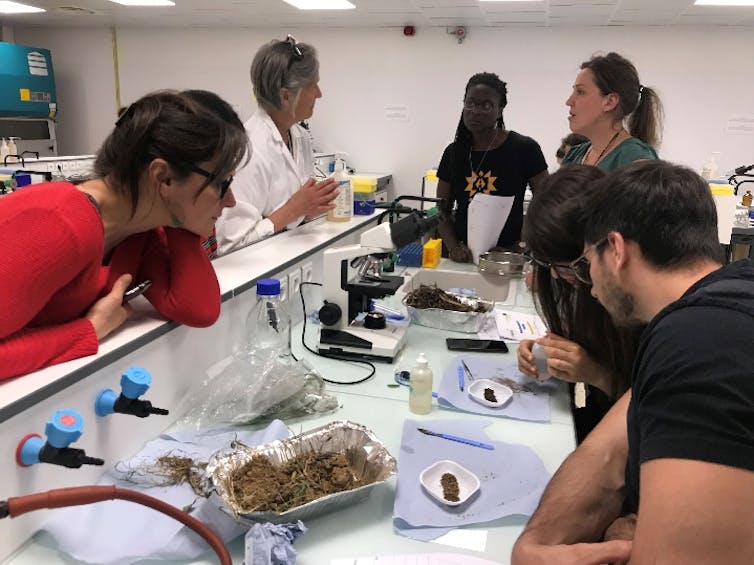Is cultivating the soils of a metropolis with a heavy industrial past a good idea?
The new big challenge for cities that want to be sustainable, ecological and resilient is to reconcile two worlds, agricultural and urban. Even if everything seems to separate these forms of space, agriculture and the city are more thought of together in modern, integrated and sustainable urban development models .
Steps are thus already at work to strengthen the food function of urban soils, according to a logic of returning to plant production as close as possible to places of consumption in the city. However, urban soils present some surprises: you have to be sure of their quality and the absence of contaminants before daring to cultivate them and produce plants in the ground.
It is also necessary to silence the received ideas according to which urban soil rhymes with polluted soil. This is sometimes the case, but not always !
Despite its heavy industrial past (petrochemicals), the Rouen Normandy Metropolis is committed to sustainable and local agriculture. It has initiated an ambitious policy for the transition of agriculture and food systems, in particular through its Territorial Food Project .
Urban agriculture is an integral part of this reflection with the aim of multiplying the places where it is practiced according to a diversity of forms, technical systems and economic models: educational farm, multifunctional or productive micro-farm, shared gardens , market gardening, eco-grazing, beehives, etc.

To follow environmental issues as closely as possible, find our thematic newsletter “Ici la Terre” every Thursday. On the program, a mini-dossier, a selection of our most recent articles, excerpts from books and content from our international network. Subscribe today .
An urban farm from fork to fork
Among these initiatives, the citizen, educational and agroecological farm of Champ des Bruyères excels in experimenting and transmitting the know-how and values of a food system from farm to fork. A former racecourse, the site has been transformed by a joint effort between the metropolis and the association of the Champ des Possibles to offer residents a green setting in which to stroll.
Installed on a plot of 2 hectares, the farm has multiple production facilities: greenhouse, shared gardens, vegetable garden, orchards, etc., and offers opportunities for the supply of fresh fruits and vegetables grown in the ground. Today, the challenge for this farm is not to produce to sell but to teach about the food transition with two major axes: gardening and cooking.

It is more a question of encouraging and raising awareness of self-production and urban gardening, which is different from the practice of market gardening as practiced by the association at its beginnings on the Repainville site .
Even if the soil and all the ecosystem services it provides occupy a privileged place in this project, they were unfortunately not sufficiently thought out during the latter's design phase. We therefore proposed, as part of the Master of Science Urban Agriculture and Green Cities course, to support the association in the process of analyzing and understanding the potential of the soil of the urban farm.
Dissect the composition of the soils
The first step was to define sampling points, so as to crisscross the entire plot, taking into account the history of these soils, in particular their origin (agricultural land brought in when crops were started), the various amendments as well as the cultural precedents. It was also necessary to take into account the two agrosystems practiced in the ground: under cover or in the open air.
Five soil samples were thus analyzed for their physico-chemical properties and their biological activities. The physico-chemistry was determined according to a very simplified and easily reproducible protocol by the members of the association invited to the analysis sessions at the UniLaSalle Campus laboratory in Rouen.

The physicochemical properties of the soil (pH, granulometry by sedimentation, determination of organic matter and calcium carbonate and determination of the cation exchange capacity) were measured. The biological components of the soil interacting with plants (endomycorrhizal colonization of roots, rhizobial symbiosis and abundance of earthworms) were also highlighted.
A little high pH
All the soils turned out to be clayey and very sandy. This presence of sand in significant quantity is a first indicator that the land is not optimal for cultivation. The draining nature of this type of soil limits the retention of rainwater or irrigation water, which generates a waste of water resources. The choice of agricultural soil during the implementation phase of the project therefore did not take into account the properties of this texture.
Second indicator of soil quality, pH measurement. The results turned out to be not very homogeneous with a tendency towards a rather high pH – greater than 7. The majority of the samples did not show the presence of limestone, except in the orchard plot (with the highest pH). Too high a pH complicates cultivation by reducing ionic exchanges and, consequently, the chances of the establishment of soil life.
Regarding the cation exchange capacity, it was measured using methylene blue. This rather favorable measure is however not optimal for encouraging the exchange of nutrients from the soil to the plant, due to the pH.
Life in the soil
As for the presence of organic matter, it was measured using hydrogen peroxide. The plots studied revealed the presence of varying amounts of organic matter. This can be explained by the different organic amendments made at the start of the farm activity.
The biological component is revealed by the existence of fungi around the plants and by the existence of bacteria sheltered in nodules. Unfortunately, during sampling, the dryness of the soil made it impossible to verify the presence of earthworms.
As far as the fungal component is concerned, we did not observe any mycorrhizae, but we found vesicles and hyphae which are all markers of the establishment of a biological life in the soil that is beneficial for the plant.
As for the bacterial component, it was observed from fabaceae roots planted in all the plots. Many nodules were highlighted, indicating intense bacterial activity allowing the fixation of atmospheric nitrogen by plants: a plus for plants and soil.
Promising soils to improve
Cultivating urban soils remains to this day an adventure whose conditions for success lie in taking into account the “soil” dimension. Even if the adage urban soil really rhymes with polluted soil, many of them remain excellent growing media provided they are observed, analyzed and improved.
The analysis detailed above makes it possible to draw certain conclusions on their condition at the Bruyères farm. The soil is indeed very draining, the physico-chemical parameters are not extreme and can be improved (tree planting, organic amendment, sowing clover, mustard, avoiding tillage and dispersal of the biological component, etc. ).
Finally, the sandy texture of the soil reinforces another structural problem of the educational farm, which is that of access to water. Even if rainwater harvesting is already in place, it is not enough given the texture of the ground. Using drinking water from the network for irrigation raises serious ethical questions.
In this pretty and ingenious device, fruits and vegetables are already growing and finding demand from consumers motivated by the local and environmental component of these products. This experiment is a starting point, which must be continued to measure the short, medium and long-term effects of soil improvement practices. ![]()
Marie Asma Ben-Othmen , Teacher-Researcher Head of the Master of Science Urban Agriculture & Green Cities, UniLaSalle and Marie-Pierre Bruyant , Plant Sciences, UniLaSalle
This article is republished from The Conversation under a Creative Commons license. Read the original article .
